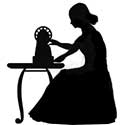Making and mending clothes in the early 1900s

There were few new shop-bought clothes among the working classes in Victorian and Edwardian times. It was normal for children to be seen in patched, hand-me-downs clothes and non-matching buttons, and for women to make their own clothes from whatever fabric became available free or at a reduced price. So it was equally normal for women of the time to be expert at sewing and mending. This page gives examples of women's skill at improvising with descriptions of standard home-sewing equipment.
____
Extracted from the memoirs of the webmaster's mother (1906-2002) and edited by the webmaster with further research and firsthand contributions from others
Examples of women's sewing skills with hand-me-downs
My mother would wash and unpick my father's trousers that were no further use to him and cut out a pair of trousers from the less worn parts to make a pair for one of my brothers.
I had a winter coat which she made from a soldier's khaki coat that came her way.
Other clothes that came her way originated from cast offs from the children in the big houses. These were given to servants who passed them on to us, but my mother invariably had to do some needlework on them to make them fit one of us.
Lynn Schoeffler's great aunt tells a typical story of receiving a hand-me-down wool coat that was faded and stained. Her mother, Lynn's great grandmother, removed the lining, picked the coat apart at the seams, turned every piece inside out, and then sewed it back together for a coat that looked new.

Sewing, dressmaking and mending at home at about the time of World War One. Note the sewing bag, the clothes and the padded wickerwork armchair. Photo courtesy of Don Billing showing his grandmother, Alice Long, born in 1855.
The sewing machine
A sewing machine of the type used in the early 1900s (and later in the century). The working part could be folded underneath and the lid could be folded down.
My mother, born 1881, told us that she had had her sewing machine since the was eighteen - which meant that it was a nineteenth century model - probably very similar to the one in the photo. We never asked how she came by it; it was probably a cast-off from somewhere. It worked by foot power via a foot treadle, and it was in constant use, apart from in the evenings as it was one of the things that annoyed my father. When the working part of the sewing machine was lifted, a catch was released, and it could be folded down and hidden underneath. Then, once the lid was lowered, the sewing machine made a table of sorts.
The sewing machine worked by foot power using a treadle, and it needed skill to keep it up at a steady rate.
Old dressmaking equipment
The sewing box
Every woman had a sewing box where she kept odd reels of cotton, pieces of wool, needles and anything else that had once been used for sewing and might be used again. There were many different styles, all invariably hand-made out of wood.

Sewing box, currently owned by Rosemary Hampton
The button box
A significant part of mending was sewing on buttons. Buttons were essential for fastening as there were no zip fasteners and no velcro. Buttons fell off with wear, so women always kept a 'button box' in their sewing box, in which they collected odd buttons to use as replacements. It was normal to see working class children wearing clothes with odd buttons and no one thought anything of it.

A 'button box' which was an old tin in which odd buttons were kept
Dressmaking scissors
Dressmaking scissors were scissors with long blades for cutting fabric cleanly. They were often taken to the knife grinder for keeping them sharp. Woe betide anyone who borrowed them for some other use.

Dressmaking scissors, tarnished because there was no stainless steel

Tailor's dummy - for those who could afford one. A properly adjusted dummy saved ages of standing for being fitted.
| sources | webmaster | contact |
Text and images are copyright
If you can add anything to this page or provide a photo, please contact me.




